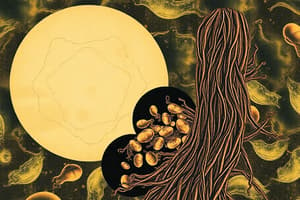Podcast
Questions and Answers
What is the primary function of the nucleolus?
What is the primary function of the nucleolus?
- To make ribosomes (correct)
- To synthesize proteins
- To store calcium ions
- To transport lipids
The smooth endoplasmic reticulum is responsible for protein synthesis.
The smooth endoplasmic reticulum is responsible for protein synthesis.
False (B)
What is contained within the core of the nucleolus?
What is contained within the core of the nucleolus?
DNA from one or more chromosomes
The __________ endoplasmic reticulum is characterized by the presence of ribosomes.
The __________ endoplasmic reticulum is characterized by the presence of ribosomes.
Match the following functions with the correct type of endoplasmic reticulum:
Match the following functions with the correct type of endoplasmic reticulum:
What happens to the nucleolus during nuclear division?
What happens to the nucleolus during nuclear division?
Ribosomes can be found both free in the cytoplasm and on the rough endoplasmic reticulum.
Ribosomes can be found both free in the cytoplasm and on the rough endoplasmic reticulum.
Which reproductive hormones are produced in the smooth endoplasmic reticulum?
Which reproductive hormones are produced in the smooth endoplasmic reticulum?
What is the Svedberg unit of measurement primarily used for?
What is the Svedberg unit of measurement primarily used for?
Eukaryotic ribosomes are larger than prokaryotic ribosomes.
Eukaryotic ribosomes are larger than prokaryotic ribosomes.
What is the primary structure that surrounds the nucleus in a cell?
What is the primary structure that surrounds the nucleus in a cell?
Ribosomes consist of roughly equal amounts of ribosomal RNA and __________.
Ribosomes consist of roughly equal amounts of ribosomal RNA and __________.
Match the following cellular structures with their functions:
Match the following cellular structures with their functions:
Which type of ribosome is found in mitochondria and chloroplasts?
Which type of ribosome is found in mitochondria and chloroplasts?
The cell surface membrane is impermeable to all substances.
The cell surface membrane is impermeable to all substances.
The __________ in plant cells makes them more visible under a light microscope compared to animal cells.
The __________ in plant cells makes them more visible under a light microscope compared to animal cells.
Study Notes
Nucleolus
- The nucleolus is a darker, rounded structure that exists within the nucleus.
- It is responsible for creating ribosomes.
- The process of ribosome creation utilizes its own DNA (containing ribosomal RNA genes).
- It also contains genes for creating tRNA (transfer RNA).
- Ribosomal subunits assemble in less dense regions of the nucleolus, incorporating rRNA together with proteins imported from the cytoplasm.
- The nucleolus' size is directly correlated with a cell's ribosome-making activity.
- Its structure only forms when ribosomes are being assembled.
- The nucleolus vanishes when ribosome synthesis ceases, as in nuclear division.
Endoplasmic Reticulum
- The ER is an extensive network of flattened sacs called cisternae, crucial for intracellular processes.
- It allows separation of internal reactions from the cytoplasm, facilitating the transport of molecules, especially proteins.
- The ER is directly connected to the nucleus' outer membrane.
- There are two types of ER: rough and smooth.
Rough Endoplasmic Reticulum (RER)
- RER is characterized by the presence of ribosomes, giving it its rough appearance.
- Ribosomes, sites of protein synthesis, are found on the RER and also freely in the cytoplasm.
Smooth Endoplasmic Reticulum (SER)
- SER lacks ribosomes, giving it a smooth appearance.
- Its functions differ from RER.
- SER synthesizes lipids and steroids, such as cholesterol, estrogen, and testosterone.
- SER is an important storage site for calcium ions, particularly abundant in muscle cells due to calcium's role in contraction.
- In the liver, SER participates in the metabolism of drugs.
Ribosomes
- Ribosomes are tiny organelles invisible under a light microscope.
- Electron microscopy reveals two distinct subunits: a large and a small subunit.
- Their sizes are often expressed in Svedberg units (S), which measure sedimentation rate in a high-speed centrifuge.
- Eukaryotic ribosomes are 80S, while prokaryotic ribosomes are slightly smaller at 70S.
- Mitochondria and chloroplasts also contain 70S ribosomes, indicating their prokaryotic origins.
- Ribosomes are composed of approximately equal amounts of ribosomal RNA (rRNA) and protein.
- Their intricate 3D structure allows the gathering of molecules crucial for protein synthesis (mRNA, tRNA, amino acids, and regulatory proteins).
Cell Surface Membrane
- This membrane is extremely thin (about 7 nm), but its three-layer structure is visible under high magnification.
- It acts as a selectively permeable barrier that controls exchange between the cell and its environment.
Nuclear Envelope
- The nucleus is enclosed by a double membrane called the nuclear envelope.
- The outer membrane is continuous with the ER.
- The nuclear envelope is dotted with numerous pores, called nuclear pores, that regulate exchange between the nucleus and the cytoplasm.
- Messenger RNA (mRNA), transfer RNA (tRNA), and ribosomes exit through these pores.
- Incoming substances include proteins (for ribosome assembly), nucleotides, ATP (adenosine triphosphate), and certain hormones such as thyroid hormone T3.
Cell Walls and Plasmodesmata
- Plant cells are more easily visible under a light microscope than animal cells because they are generally larger and possess a cell wall.
- The cell wall is a rigid outer structure that lies outside the cell membrane.
- Cellulose fibers within the wall provide strength and give the cell a defined shape.
Studying That Suits You
Use AI to generate personalized quizzes and flashcards to suit your learning preferences.
Related Documents
Description
This quiz covers the key structures and functions of the nucleolus and the endoplasmic reticulum in cellular biology. It explores the roles of the nucleolus in ribosome synthesis and the importance of the ER in intracellular transport and molecular processing. Test your understanding of these crucial cellular components!




